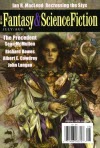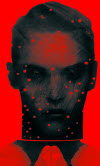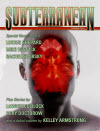Short Fiction: October 2010
The wide variety of metaphor and symbolism available in speculative fiction allows authors to tackle a bewildering variety of topics. One of the most disturbing issues that authors can wrestle with is child abuse. This month I present three recent stories that broach the subject using entirely different sets of tropes: historical slipstream, near future SF, and secondary world fantasy. Child abuse is an extremely emotional subject and must be handled with care. Presumably some authors could exploit it for a cheap emotional boost, but it seems that just about every editor knows better than to allow such a story out of the slush pile. The authors here take their subject matter very seriously.
 Two recent stories are told from the first person perspective of the victim, now grown. The narrators of both Richard Bowes’ novelette “Pining to be Human” (described as autobiographical) and Rachel Swirsky’s “The Monster’s Million Faces” are men who were molested by strangers as children. In “Pining,” (July/August Magazine of Fantasy and Science Fiction) the time period is the 1960s. The (unnamed) narrator is messed up in a whole number of ways: he had a childhood concussion, he was molested by a man in the subway when he was thirteen. Since then he’s flunked out of one college, graduated from another by the skin of his teeth, sold himself for sex to men who think he’s underage (which gives him the money for his therapist), dodged the draft with the help of his therapist, and lived as part of a bisexual love triangle that melts down dramatically. He makes a living as a writer for awhile before completely losing it thanks to his drug habit, and finally winds up in rehab after hitting rock bottom.
Two recent stories are told from the first person perspective of the victim, now grown. The narrators of both Richard Bowes’ novelette “Pining to be Human” (described as autobiographical) and Rachel Swirsky’s “The Monster’s Million Faces” are men who were molested by strangers as children. In “Pining,” (July/August Magazine of Fantasy and Science Fiction) the time period is the 1960s. The (unnamed) narrator is messed up in a whole number of ways: he had a childhood concussion, he was molested by a man in the subway when he was thirteen. Since then he’s flunked out of one college, graduated from another by the skin of his teeth, sold himself for sex to men who think he’s underage (which gives him the money for his therapist), dodged the draft with the help of his therapist, and lived as part of a bisexual love triangle that melts down dramatically. He makes a living as a writer for awhile before completely losing it thanks to his drug habit, and finally winds up in rehab after hitting rock bottom.
This is mainly a straight-up piece of historical and character fiction. A light fantastic motif comes in from the “Witch Girls,” characters from the play “Dark of the Moon,” that show up at various intervals in his life. In the play, they are evil characters who trick the Witch Boy, who wants to be human to live with his mortal love, into staying a Witch. The narrator is completely upfront about decoding the symbolism here: when his college theatre department puts on the play, everyone uses “Witch boy” as code for gay and “Human boy” as code for straight. At the very end, when he has finally decided to clean up instead of descending into chaos and death, the Witch Girls show up in a comforting and soothing role, indicating that he is finally making peace with himself, his sexuality, and his identity.
 “The Monster’s Million Faces” (September on Tor.com) is set in the near future. Aaron was abducted as a child, held for five days blindfolded and with ears plugged, molested repeatedly, then dumped back into his old life. He is a functional adult, working for a law firm, but when a female co-worker harasses him he flips out and gets violent, hence, the therapy. The key technology in the story is memory grafts. The idea is that erasing memories doesn’t really work, but you can implant positive resolutions to those memories. The problem is in finding an imaginary resolution that will actually provide the victim with lasting comfort. Once the patient and therapist come up with such a scenario, it will be implanted into the brain with concomitant stimulation of the amygdala.
“The Monster’s Million Faces” (September on Tor.com) is set in the near future. Aaron was abducted as a child, held for five days blindfolded and with ears plugged, molested repeatedly, then dumped back into his old life. He is a functional adult, working for a law firm, but when a female co-worker harasses him he flips out and gets violent, hence, the therapy. The key technology in the story is memory grafts. The idea is that erasing memories doesn’t really work, but you can implant positive resolutions to those memories. The problem is in finding an imaginary resolution that will actually provide the victim with lasting comfort. Once the patient and therapist come up with such a scenario, it will be implanted into the brain with concomitant stimulation of the amygdala.
“People need different things — resolution, confrontation, revenge, absolution, the answer to a question. We’ll keep inducing hypnosis until we find a scenario that works.”
She leaned forward, catching my eye.
“This is just the start — bandaging the wound, as it were. You’ll still need therapy afterward.”
I waved off her provisos. “Won’t I remember sitting here, talking about it? Won’t I know it’s fake?”
Dana shrugged. “We’ve known for a long time that false memories feel true. Intellectually, you’ll know it’s fake. Emotionally and therapeutically, it’ll be true for you.”
The bulk of the story consists of Aaron working through different scenarios: revenge fantasies where he kills the man (who he never saw and can hardly imagine), times when the man asks for forgiveness, times when he is re-violated, all different kinds of images. At the same time we get glimpses of his life: his alienation from his parents, his inability to form meaningful relationships, his view of his life as ‘claustrophobic’ and ‘lightless.’ At one point his father, who’s been told that Aaron’s off work because of a physical injury, says: “Young people heal up fast. You’ll be better any day now.” At that moment in the story it really twists in the knife: children may recover quickly from physical wounds, but psychic wounds can last forever. At the very end of the story Aaron finally does find a scenario that gives him some peace. It’s not perhaps the image or response that you’d expect to be positive, but it convinced me.
 Finally, Lucius Shepard has a novella, “The Taborin Scale,” in the Summer 2010 issue of Subterranean that features an abused child. We start with George, a numismatist who enjoys spending his vacations in Teocinte. This country lives in the shadow of a gigantic dragon, Griaule, who is literally as big as hills. It hasn’t moved in centuries, but likewise hasn’t rotted away. There is much debate as to whether it is living or dead, but Teocinte does a good trade in relics (real and fake) related to the dragon. In one bundle of odds and ends that George buys, he finds a dragon scale. It attracts the attention of the prostitute Sylvia (not her real name), who offers to be his companion for two weeks in return for the scale. As George is cleaning and polishing the scale, it transports them in time. They are in the same place, but there is no town and no gargantuan dragon. There is a small dragon that looks like Griaule might have in its youth. It herds George and Sylvia towards water, and then leaves them alone.
Finally, Lucius Shepard has a novella, “The Taborin Scale,” in the Summer 2010 issue of Subterranean that features an abused child. We start with George, a numismatist who enjoys spending his vacations in Teocinte. This country lives in the shadow of a gigantic dragon, Griaule, who is literally as big as hills. It hasn’t moved in centuries, but likewise hasn’t rotted away. There is much debate as to whether it is living or dead, but Teocinte does a good trade in relics (real and fake) related to the dragon. In one bundle of odds and ends that George buys, he finds a dragon scale. It attracts the attention of the prostitute Sylvia (not her real name), who offers to be his companion for two weeks in return for the scale. As George is cleaning and polishing the scale, it transports them in time. They are in the same place, but there is no town and no gargantuan dragon. There is a small dragon that looks like Griaule might have in its youth. It herds George and Sylvia towards water, and then leaves them alone.
They both adapt quickly to their circumstances, attending to practicalities such as food, water and shelter. In a few days, George forages away from their camp and finds himself in an altercation with some unfriendly people who have also been transported. In the process he rescues a child from them.> Peony had been suffering almost daily abuse at their hands. As they are running back to their camp, the young dragon shows up again to let George know that he needs to stick closer to his own camp after this. So George, Sylvia and Peony come to form something of an ad hoc family. Peony is a desperately damaged individual. She had been sexually abused routinely by both her mother and her father. After they were transported in time another fellow, Edgar, joined them. Instead of rescuing or helping her, he joined in the abuse. She is only occasionally coherent, and is mostly checked-out from reality. She believes the dragon is talking to her in her mind.
The first night after George rescued Peony, someone came to him as he was sleeping and gave him a quick blow-job. He assumed it was Sylvia, thanking him for rescuing the girl. But a few months later, he has cause to doubt. He and Peony are out foraging for food, and they stop to nap. He wakes up to find the girl fondling him. He pushes her away and lectures her about not having to do that anymore. But he begins to doubt himself — was it Sylvia that first night? Did he push Peony away fast enough? Was there something prurient in their relationship? He distances himself from Peony even more, forbidding her to even hug him. At this point she’s so disassociated it doesn’t seem to affect her much.
Eventually Edgar tries to infiltrate their camp, bringing a friend along. George kills the friend and Sylvia kills Edgar, acts that bear emotional consequences. Not long after that, the dragon herds all the transportees into an amphitheatre (shifting time again) for the big finale, which I’ll leave to the reader. It is appropriately cataclysmic. In the epilogue we skip forward about a decade. George and Peony live together as father and adopted ward, but there are rumors of an inappropriate relationship. However, having suffered amnesia regarding everything that happened before the cataclysm, Peony seems to have transformed into a relatively healthy, functional adult.
This story is complemented by several footnotes. In one, there is an implication that the world George and Sylvia live in is actually our own Earth at some other time. In another, we learn a bit about what George thinks has actually happened when they were transported through time:
9. Though a rift in time or dimensionality would seem to be indicated, George subscribed to the theory espoused by Peri Haukkola, holder of the Carbajal Chair of Philosophy at the University of Helvetia. Haukkola believed that people under extreme stress could alter the physical universe even to the point of creating pocket realities, and George assumed that a reality formed by Sylvia’s self-avowed identity crisis comprised the relatively empty landscape they currently inhabited.
This seems like a somewhat random note in the story, but the narration returns to it a few times. I wonder if it isn’t pointing to the possibility that this adventure is a pocket universe created by Peony — the dragon Griaule, shadowing over everything, would represent her universe of abuse. The people transported to the pocket universe rescue her from her abuse and start to care for her. When they finally kill her abusers, the cataclysmic event happens, washing her clean of her memories and allowing her to be in some way reborn. I may be forcing this reading of the story, but it gives heft to some of the rather gargantuan metaphors lurking around the tale. I strongly encourage you to go and read this one and see what interpretation strikes you. Like all good literature this story can be read on multiple levels.
All of these stories are intense and disturbing, and point to the lasting effects of child abuse and molestation. In each, the victims are disassociated and alienated from their realities; only somewhat functional in their own lives. Shepard’s novella also delves into the effect that abuse can have on others, as George begins to doubt himself and his own motives, and succumbs to fear that he could unintentionally perpetuate the abuse. I’d also note that Peony is what I’d describe as a more ‘typical’ abuse victim: she was abused repeatedly by family members. The men in the other two stories were molested in one-off encounters with strangers, which I understand is less common. In any case, this fundamental betrayal by the world leaves all of them unable to trust or to form meaningful attachments to other people. Of the three I’d say that Swirsky’s tale is the most horrific and intense, while Shepard’s is the best written. (I have long admired Shepard’s skill with prose and structure. He is one of my favorite stylists in the field, along with Jeffrey Ford.)
It strikes me that SF/F is particularly well suited to discuss intense emotional issues such as abuse. With its ability to cast stories into worlds of literalized metaphor, it can bring out the emotional significance of these themes in a wide variety of ways. In “Monster’s Million Faces,” Aaron gets to mentally confront his abuser in diverse guises, finally working out his fundamental question. The narrator of “Pining to be Human” wrestles with his identity, but finally sees the threatening Witch Girls as comforting figures. The oppressive dragon of “The Taborin Scale” ends in a fiery cataclysm. In each case this seems to lead to healing and a measure of peace. I hope that stories such as these can lead to a hope of comfort for real-life victims of abuse, and can lead non-victims to greater understanding of the continuing issues facing those afflicted.
Thanks! This was interesting.
Pingback: Black Gate » Blog Archive » Short Fiction Roundup